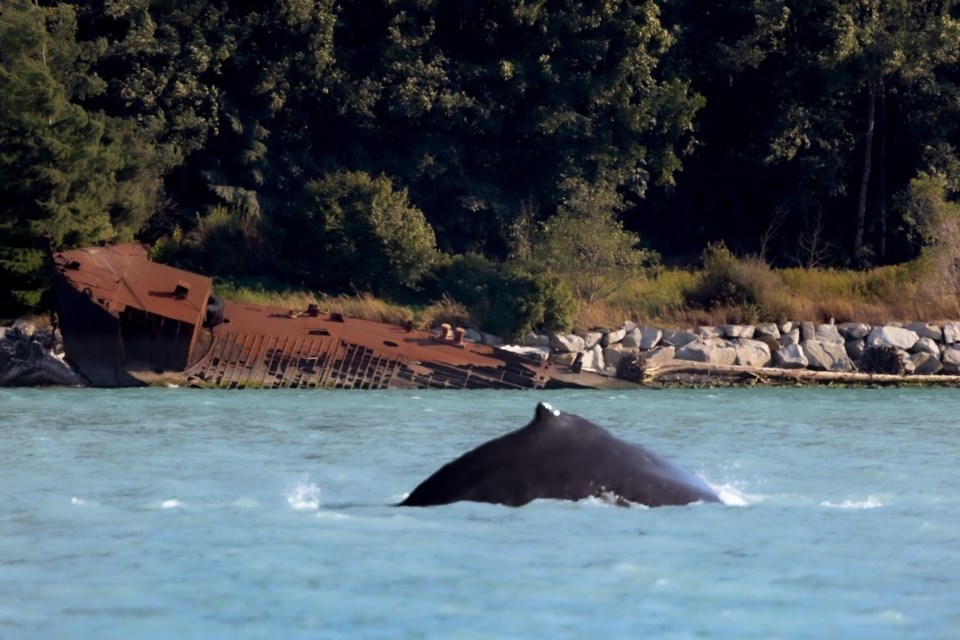A rare and special visitor made a splash in Howe Sound this weekend.
David Crewson of sailing adventure company was out on the sound with clients when they spotted the lone humpback whale swimming north near Watts Point.
It has been about a decade since the last report of a humpback this close to Squamish, according to Crewson.
The whale spotted Saturday swam up to the mouth of the Mamquam Blind Channel.
"As it entered the river current, it started to breach and probably breached a dozen times, which was incredible," he said.
It kept breaching as it headed back south.
"It was pretty phenomenal," Crewson said, noting the folks he had onboard had been on sailing trips with him but had never ever seen anything like a humpback whale breaching in Squamish waters. Neither had Crewson.
"For people to witness that, it created such an incredible moment," he said. "It's just one of those heartening moments when you see after all the hard work that was done in order to help remediate the natural ecosystem, to see that it's actually working."
He said credit needs to go to those who worked to remediate the sound, thus improving the local herring population.
According to researchers, the humpback is Cassiopeia, and he has been tracked dating back to 2008.
, Marine Education and Research Society researchers, representing the Canadian Pacific Humpback Collaboration, said there had been previous sightings of this particular whale in Howe Sound.
"He is known to have migrated to Mexico. He has scarring from having been struck by a boat," the post states.
Sightings of humpbacks should be reported to , the researchers added.
Crewson also noted the importance of keeping a good distance from marine life, as he did.
Most other folks out on the water kept a good distance, but he saw one vessel that seemed to be chasing down the whale.
He said those on the water have a legal and moral responsibility to view marine life respectfully.
Safe viewing of marine life Canadian Fisheries and Oceans (DFO)
The department asks the public to call the DFO Observe, Record, Report (ORR)/ Marine Mammal Incident Hotline at 1-800-465-4336, to report occurrences of whales being harassed or disturbed and instances of collision with whales or whale entanglements. Mariners who are unable to reach the incident reporting hotline can call CCG’s Marine Mammal Desk at 1-833-339-1020 or CCG radio.
Returning
, said though a few humpbacks sometimes hang out together, it isn't unusual that the whale was by itself.
"That's normal this time of the year. Sometimes you've got mothers and calves. Sometimes it can be paired up, but they tend to be somewhat loners when they're feeding, so they don't have the same family structure like our killer whales do," he said.
They come north to feed from the spring into the wintertime. If they are sexually mature, Trites said they would head either to Mexico to breed and give birth or to Hawaii. Most of them go to Hawaii, but there's also a breeding population from Mexico.
He said while it is rare for us these days to see a humpback, it isn't a new thing.
"If you'd been in Squamish 150 years ago, then it would have been a normal thing. It's that the humpback whales have come back."
Trites said it is believed there were somewhere between 100 and 150 humpback whales that came every year to the Strait of Georgia.
"In fact, the very first whale-watching business took people by steamship from Vancouver to Bowen Island in December to watch humpback whales," he said.
Devastation came to the whales, however, in 1907.
"That's when the Pacific Whaling Company…moved to Pipers Lagoon at the north end of Nanaimo, and they began to whale. They took their whaling crews from the other coast of Vancouver Island to the Strait of Georgia," he said.
There were protests of the whaling but to no avail.
"It took three years, and they killed every last one."
Thus, that very first whale-watching business got shut down because the whales were all killed, Trites said.
"It took just over 100 years [for them] to come back."
As for why the return to the sound, he said that the healthier environment plays a role, but is not the only reason.
"The whales are still discovering their historic feeding grounds. And so they're still exploring new areas. And whether or not this individual has found another good area, and willl keep coming back, time will tell. But there's no doubt that if you improve the water quality, then you're going to improve the quality of the prey too. And that is a sign of a healthier ecosystem."
He said where the whale is specifically headed next is anyone's guess, perhaps towards Bowen Island.
"Maybe it comes back again. It depends on how it made out," he said.
However you look at it, this spotting of a humpback in Howe Sound is a positive sign, he said.
"Every day when one sees a whale, it's a good sign that we're doing things right and doing things better to keep the waters healthy... It's also kind of a sign that the whales are learning to adapt to us. We have changed their home, and we now need to learn how to adapt to them as well, to ensure that it is a safe place for them to come."
**Please note, we corrected the story to say this was the first time in years a humpback was seen this close to Squamish. Others were seen previously in Howe Sound in recent years.
**Please note that this story has been updated to add information provided by researchers.


.png;w=120;h=114;mode=crop)

